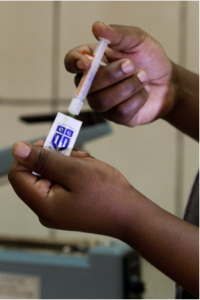
Saving lives and making our aid dollars more effective with gizmos, gadgets, and groundbreaking partnerships was front and center last week during the launch of USAID’s new Global Development Lab.
The goal of the Lab is to improve or save the lives of more than 200 million people in the next five years.
But how? The Lab brings together multiple government offices, initiatives, and competitions for new development partners under one digital roof “to invent, test, and scale the most promising and cost effective solutions to end extreme poverty,” said USAID Administrator Rajiv Shah during the launch event. Looking outward, the Lab is designed to engage “a global community of inventors, academics, researchers, entrepreneurs, investors, and corporate leaders in science and technology.”
As ambitious as that sounds, the Lab actually comes with its very own group of “Cornerstone Partners” – e.g., 32 brand-name businesses, top U.S. universities, and global NGOs and foundations – who understand why the right thing to do, is also the smart thing to do.
The Lab may be brand new, but many of the collaborations and initiatives have been underway for a few years. Take Duke University, one of the Lab’s Cornerstone Partners, and a series of competition-based initiatives called, “Grand Challenges.”
When USAID announced the “Saving Lives at Birth” challenge a few years ago, hundreds of nonprofits, tech start-ups, and universities have jumped to participate in this “global call for groundbreaking, scalable solutions to prevent infant and maternal deaths.” – including Duke University’s Professor Dr. Robert Malkin and his students, who entered the Pratt Pouch into the grand challenge competition.
 The result: a major weapon was added to the fight to end HIV/AIDS: breaking the mother-to-child HIV transmission cycle.
The result: a major weapon was added to the fight to end HIV/AIDS: breaking the mother-to-child HIV transmission cycle.
Did you know every day, around 1,000 children contract HIV worldwide, and 90% are transmitted from mother to newborn babies? And in developing countries, where women often deliver babies at home, an HIV-infected mother is more likely doomed to pass along the disease to her child.
The Pratt Pouch may not appear to be much more than a McDonald’s ketchup packet with the Duke University crest instead of “golden arches,” but inside there’s a ready-made dose of antiretroviral medication that can help prevent this from happening.
With any new technology or medical idea, the early stages are extremely risky, and often, the private sector isn’t willing to invest. But winning the Saving Lives at Birth competition turned this big idea into a game-changing, scalable solution.
Partnering on global development is in the air. At a recent event, PYXERA Global demonstrated the power of harnessing public-private partnerships. This attracted CEOs and senior executives from Dow Chemical Company, IBM, Ernst & Young, Intel, and JPMorgan Chase Foundation to our nation’s capital.
Why? Because they see the strategic value of partnering with foreign assistance agencies and civil society, including the heads of organizations like PSI and the One Campaign, who also participated in PYXERA’s forum. Each of panels provided varied examples of how market expertise, cutting-edge science, and generosity are solving global problems in new and exciting ways.
The overarching theme: The desire and commitment to collaborate more often and in a better way to foster growth and opportunity worldwide.
Capitalizing on private expertise and new breakthroughs in technology is making our aid dollars more effective, saving more lives, and revolutionizing the way the U.S. government – and the world – solves global challenges.
The USGLC is proud to include the Pratt Pouch in our Innovations in Smart Power Campaign – sponsored by Coca-Cola, Carlson Hotels, Land O’Lakes, and PYXERA – which looks at the unique way the government, NGOs, development professionals, and businesses are working together to create real solutions for eradicating poverty, for advancing our security, and for advancing our economic interest.